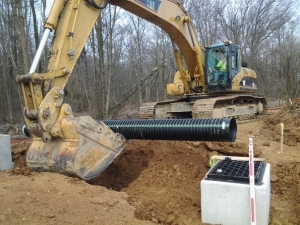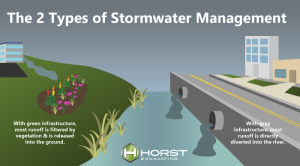Stormwater Management: What It Is & Why It Matters
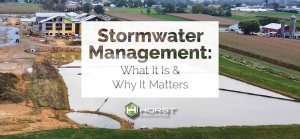
There have been several years of record-setting precipitation in the Mid-Atlantic, and Pennsylvania is no exception. 2016-2020 was the wettest five-year period in Pennsylvanian history[1], and the heavy rains haven’t let up. During severe or days-long storms, it’s not abnormal to see local rivers swell and roads flood.
What do we do with all this rain?
As the Mid-Atlantic adjusts to a wetter climate, our buildings, and the land they sit upon need the ability to handle large amounts of precipitation at once safely. The way to do that is to plan robust stormwater management systems. While local governments do their part, so too must individual property owners and organizations. Many townships and cities have specific requirements for how the stormwater from your property is handled.
In this blog, we’ll look at how stormwater management systems work, why they’re important, and which type may be the best for you.
What Is Stormwater Management?
Stormwater management is the practice of diverting rain runoff to appointed areas designed to hold or divert the water.
Pervious surfaces, like vegetated earth, absorb rainwater and divert it into the ground. But when expanding the built environment, these surfaces are often replaced with impervious surfaces like pavement and buildings. Impervious surfaces prevent rainwater from flowing into the ground (though porous pavements are an exception). All this rain runoff from impervious surfaces needs to go somewhere, or it can cause flooding and damage to property. This is where stormwater management comes in.
How does stormwater management work? The process will vary with the type of solution implemented, but will generally follow these steps:
- Rain falls from the sky.
- After sufficient precipitation, the rainwater begins to pool. This happens more quickly in built-up areas, like roads, large buildings, and parking lots.
- To reduce the effects of flooding, infrastructure diverts the pooling water to an area that can hold the runoff.
- As the precipitation stops and the ground dries, the water releases into the ground or bodies of water.
The Two Main Types of Stormwater Management
There are two categories of stormwater management solutions: gray and green infrastructure.
Gray stormwater solutions include things like sewers, curbs, gutters, and drainage pipes. Their focus is to divert the excess water away from the impervious surfaces of the built environment. Typically, over half of the precipitation in impervious areas will become runoff, with about 15% being absorbed into the ground. The remaining 30% will evaporate[2].
These methods have been used for many years and make up a sizable part of our area’s stormwater management systems. However, heavier rains and the reduction of pervious surfaces are challenging gray infrastructure. Many developers, building owners, and local governments are shifting to green infrastructure as a better solution.
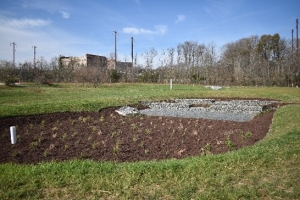
With these methods, only around 10% of the precipitation becomes runoff. Natural ground cover absorbs about 50% of it into the ground, and the remaining 40% evaporates[3].
Green infrastructure supplies a variety of benefits over traditional gray infrastructure options. It is better at reducing flooding and helps to improve the quality of our water. As a bonus, these options can improve the aesthetics of a property, sometimes even creating a park-like atmosphere.
Why Stormwater Management Is Important
Managing stormwater has two main benefits: it reduces the effects of flooding and creates cleaner waterways.
Firstly, let’s look at flooding. You don’t need to live in an abnormally rainy area to understand the power and danger behind a large amount of water. The more impervious surface is in an area, the worse it can be.
The traditional use of gray infrastructure in the form of gutters, curbs, pipes, and sewers quickly diverts runoff from impervious surfaces into nearby bodies of water. While this can be sufficient, above-average rainfall can inundate this system, pumping more water into our creeks, streams, and rivers than is safe for nearby homes and infrastructure.
Many green infrastructure rainwater systems work to slow this process, creating localized pervious surfaces to divert rainwater to. Slowly releasing it into the ground allows a more gradual flow of water into the streams, rivers, and lakes while still diverting it from impervious surfaces.
These newer types of rainwater systems also help to improve the health of our waterways. As rainwater falls, it collects on and runs off impervious surfaces. While it’s there, it mixes with whatever is on those surfaces, such as motor oil, industrial chemicals, manure, and more.
In natural environments, plants, rocks, and sand filter out pollutants before they reach larger bodies of water. But with many methods of traditional runoff infrastructure, this gray runoff ends up in waterways without being filtered.
Many newer types of rainwater systems integrate with or draw inspiration from natural environments. Sitework engineers and contractors create areas where the rainwater first passes through vegetation or other natural filtration systems. This helps create cleaner water and helps reduce the buildup of sediment in the waterways.
What Kind of Stormwater Management Is Best?
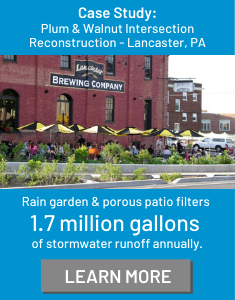
While gray stormwater management systems aren’t typically as good at preventing flooding and enhancing the environment as green systems, they can be fast and cost-effective. They also need less space, so if you’re on a tight site, it may be your best option.
Green infrastructure can supply a park-like atmosphere, while also better managing runoff. That said, you’ll need the space to implement it.
Many projects mix the two, combining the benefits of both into a system that works for their property.
Overall, your stormwater management plan is an important aspect of your project. Not only does it affect the short- and long-term health of your building and property, but it can also impact those around you. Be sure to partner with a knowledgeable site contractor that can not only successfully execute the project but can contribute to the planning process along the way.
[1] https://statesummaries.ncics.org/chapter/pa/
[2] https://www.epa.gov/sites/default/files/2015-10/documents/chesbay_chap03.pdf
[3] https://www.epa.gov/sites/default/files/2015-10/documents/chesbay_chap03.pdf
Posted May 20, 2022

